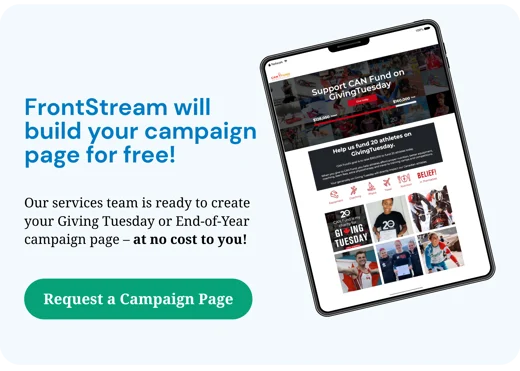
The end-of-year (EOY) fundraising rush is upon us. Giving Tuesday and the holiday season offer a critical window to maximize your impact before the clock strikes midnight on December 31st. And with countless campaigns vying for donor attention, standing out is more crucial than ever.
Enter AI — a game-changer in helping you craft compelling narratives and reach the right audiences.
Are you ready to harness the power of artificial intelligence to inspire generosity and drive donations?
Let’s dive into 17 AI prompt templates and more to help you supercharge your Giving Tuesday and EOY fundraising campaigns!
What is AI, & How Does it Help Nonprofit Fundraising?
Artificial Intelligence (AI) is the simulation of human intelligence in machines that are programmed to think like humans and mimic our actions.
In the context of fundraising, AI can save you a lot of time and help you:
- Analyze vast amounts of data to identify donor patterns
- Predict giving behavior to aid your future outreach strategies
- Craft highly personalized message to supporters
How Do Nonprofits Engage with AI for Fundraising?
It’s all about your “prompts.” A prompt is a piece of text or a question that you provide to an AI model, like ChatGPT, to guide its response.
It's like giving instructions to a highly intelligent personal assistant.
When it comes to writing prompts related to your donor management, live events, and fundraising campaigns, the prompt possibilities are endless! They can help you:
- Generate social media posts (or a whole social media content calendar!)
- Write compelling donation appeals
- Create thoughtful thank-you messages to donors
- Organize promotional strategies for fundraising events like walkathons, galas, and EOY giving campaigns 😉
- And. So. Much. More.
Why Writing Good Prompts Matters for Nonprofits
Not all prompts are created equally, and crafting effective prompts is essential for harnessing the full potential of AI for your fundraising goals.
A well-written prompt significantly influences the quality and relevance of the AI's response. A good prompt should clearly communicate your desired outcome and provide necessary context. It’s the foundation for generating compelling content that resonates with your audience.
Conversely, a poorly written prompt often leads to irrelevant, inaccurate, or even nonsensical results. For example, a vague or ambiguous prompt like "write something about charity" will likely produce generic and unhelpful content.
5 Tips to Write Great Prompts for Fundraising Campaigns
1. Set the Stage: Define Your Goals and Audience
- Clearly articulate your desired tone: Specify the emotional impact you want to achieve (e.g., urgent, hopeful, inspiring).
- Outline your preferred style: Determine the overall feel of the content (e.g., conversational, formal).
- Provide examples: Share similar campaigns or content that captures your desired tone and style.
Example Prompt: "Write a fundraising appeal for my children's cancer organization, Little Golden Fighters. Get a sense of our tone and style from our website: [provides website link]. Specifically, I want a tone of urgent hope, like a personal letter from a grateful parent. For reference, here are a couple of campaigns that capture the tone and style I’m looking for: [provides links].”
2. Provide Essential Context
- Share your organization's mission: Clearly communicate your nonprofit's purpose.
- Identify your target donor: Describe the ideal supporter in detail (e.g., age, interests, values).
- Outline campaign goals: Specify the desired outcome of the fundraising campaign.
Example Prompt: "Create a social media post for Ghost Panther Foundation [provides link to website], a wildlife conservation organization centered on restoring the panther population in the Everglades. Our target audience is young professionals and college students concerned about the dwindling panther population due to climate change and property development. We aim to raise $50,000 for our panther rehabilitation program via our Giving Tuesday campaign: 9 Lives of Gratitude."
💡The more specific context you include in your prompt, the more useful the AI response will be for you!
3. Write Like a Human
- Use plain language: Avoid complex or technical terms.
- Sound conversational: Employ contractions and everyday language.
- Vary sentence structure: Create engaging and rhythmic text.
Example Prompt: "Write a grant proposal for my homeless shelter using simple, clear language and avoiding jargon. Focus on storytelling and the impact of Between Homes' services [lists services and shares a link to the website]."
4. Encourage Personality and Emotion
- Add a human touch: Ask the AI to write from the perspective of a beneficiary or volunteer.
- Share compelling stories: Request anecdotes or personal experiences to connect with donors.
- Evoke emotions: Aim for content that inspires empathy, gratitude, or urgency.
Example Prompt: "Write a donor thank-you letter from the perspective of a child named [Child’s Name] who benefited from the Happy Bellies program [provides a link to website], focusing on the impact of their donation. Include this quote from the child’s caretaker in the letter: [provides quote]. "
5. Refine and Improve
- Provide constructive feedback: Clearly communicate what you like and dislike about the AI's output.
- Experiment with different prompts: Try various approaches to find the best results.
- Combine AI and human creativity: Use AI as a tool to enhance your own writing.
Example Prompt: "Generate 10 more different headlines for a fundraising email campaign about clean water access, but this time focus on creating a sense of urgency and impact. Also include a statistic from this recent report: [includes link to report website]."
Refining Your Nonprofit Fundraising Prompts
To maximize the potential of your AI prompts, it's crucial to iterate and refine them based on the results you get. Here are some examples of follow-up questions and refinement techniques:
Follow-up Questions to Ask Yourself as You Refine Your Prompts
- Is the tone appropriate for our target audience?
- Does the content align with our organization's mission and values?
- Is the call to action clear and compelling?
- Does the content evoke the desired emotions?
- Is the content factually accurate and informative?
- Can the content be easily adapted to different channels (social media, email, etc.)?
Refinement Techniques for Your Fundraising Prompts
- Adjust the prompt length: Try shortening or lengthening your prompt to see if it impacts the output.
- Change the prompt focus: Shift the emphasis of the prompt to generate different content.
- Experiment with different keywords: Incorporate new keywords to explore alternative ideas.
- Specify the output format: Request the AI to generate content in a specific format (e.g., headline, social media post, email subject line).
- Provide examples: Show the AI examples of the desired output to guide its generation.
Example:
- Original prompt: "Write a social media post about our new animal shelter."
- Refined prompt: "Write a heartwarming social media post about the importance of adopting a shelter pet, targeting young adults, and including a strong call to action to visit our shelter."
💡 The easiest way to refine your prompts is to edit original prompts instead of piling onto the thread:

By continuously refining your prompts and analyzing the results, you can significantly improve the quality of your AI-generated content and achieve better results for your fundraising campaigns.
17 AI Prompt Templates for Giving Season Campaigns
If this is all new to you, don’t fret!
Here is a list of solid AI prompt templates to get you started on your Giving Season campaigns:
1. Identify untapped donor segments
"Brainstorm potential donor segments for a [your cause] organization that have not been traditionally targeted for end-of-year giving [or Giving Tuesday]. Consider demographic, geographic, and psychographic factors."
2. Create engaging donor experiences
"Brainstorm innovative ways to enhance the donor experience during the end-of-year giving season for a [your cause] organization. Consider gamification, personalized messaging, and exclusive rewards."
3. Leverage social media effectively
"Identify key social media platforms and content formats to maximize engagement and donations for a [your cause] organization during the end-of-year giving season."
4. Optimize donation channels
"Analyze potential donation channels and platforms to determine the most effective options for a [your cause] organization. Consider factors such as donor demographics, ease of use, and transaction fees."
5. Generate thematic concepts
"Brainstorm potential themes for an end-of-year giving [or Giving Tuesday] campaign for [your organization]. Consider the organization's values, target audience, and the spirit of the season." [Include a link to your website and/or your mission statement in the prompt.]
6. Develop a campaign schedule
Create a detailed campaign schedule for a [your cause] campaign spanning [timeframe]. Consider a multi-channel approach, including social media, email, direct mail, and events. Identify key milestones, deadlines, and performance metrics. Prioritize channels based on target audience demographics and preferences.
7. Come up with a campaign slogan
"Develop a list of catchy and memorable slogans for an end-of-year giving [or Giving Tuesday] campaign based on the theme of [theme]. The slogan should inspire action and convey the campaign's message."
8. Visualize campaign elements
"Describe the visual elements and overall aesthetic for an end-of-year giving [or Giving Tuesday] campaign based on the theme of [theme]. Consider color palettes, imagery, and typography." [Include your brand colors in the prompt for extra guidance.]
9. Identify campaign storytelling angles
"Develop compelling storytelling angles to support the theme of [theme] for an end-of-year giving [or Giving Tuesday] campaign. Focus on highlighting the impact of donations and connecting with the target audience."
10. Create a campaign hashtag
"Generate a list of relevant and engaging hashtags for an end-of-year giving [or Giving Tuesday] campaign based on the theme of [theme]. The hashtag should be easy to remember and share."
11. Develop a text-to-give campaign keyword
"Generate a list of relevant, short text-to-give keywords for supporters to use to donate via their mobile phones for an end-of-year giving [or Giving Tuesday] campaign based on the theme of [theme]. The text-to-give keyword should be easy to remember and type on a smartphone."
12. Craft a compelling mission statement
"Write a powerful and concise mission statement for a [your cause] organization that clearly articulates its purpose and inspires support."
13. Develop a strong call to action
"Create a compelling call to action for an end-of-year giving [or Giving Tuesday] appeal for a [your cause] organization. Focus on creating a sense of urgency and impact."
14. Write a heartfelt donor thank-you
"Compose a personalized thank-you message for donors to a [your cause] organization, expressing gratitude and highlighting the impact of their gift."
15. Create engaging social media copy
"Write engaging social media posts to promote an end-of-year giving [or Giving Tuesday] campaign for a [your cause] organization. Use strong visuals and compelling storytelling."
16. Develop email campaign content
"Outline a series of emails for an end-of-year giving [or Giving Tuesday] campaign for a [your cause] organization. Include subject lines, preheaders, and engaging content."
17. Write compelling campaign website copy
"Develop compelling copy for a donation website focused on [cause]. The copy should clearly articulate the nonprofit's mission, impact, and call to action. Incorporate persuasive storytelling elements, highlight donor benefits, and optimize for SEO. Include sections for homepage, donation page, about us, and impact reports."

Simplify Fundraising
Over 31,000 nonprofits & schools have trusted FrontStream to simplify their charity auctions, galas, peer-to-peer events, and online fundraisers.



